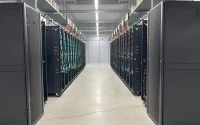The air in Silicon Valley always feels different in early September. It’s a strange cocktail of late-summer heat and the electric hum of anticipation. I was at the Tetra Hotel the night before Apple’s “Awe Dropping” event, and you could feel it in the conversations, in the nervous energy of the reporters and guests gathered for the welcome dinner. The question hanging over every handshake was the same: would this be another iterative step, or would we see something that genuinely shifted our perspective?
In the days leading up to the stream from Cupertino, the financial wires were buzzing with a different kind of question. Analysts, peering at charts that showed Apple’s stock lagging behind the S&P 500 since a sell-off back in April, wondered if the launch would create “enough of a stir” to juice holiday sales. It’s a valid question, if you’re looking at the world through a ticker tape. But it’s the wrong question. It’s like asking if the first printing press would be good for the quarterly earnings of scribes.
What we saw on September 9th wasn’t about stirring the market for a quarter. It was about fundamentally changing the relationship we have with the devices in our pockets. It was the moment the iPhone stopped being just a beautiful window onto the digital world and started becoming an active partner in how we perceive the real one.
More Than Metal: The Anatomy of a Thinking Partner
The Sensory Upgrade
On the surface, the iPhone 17 is an impressive piece of engineering. A stunning 6.3-inch Super Retina XDR display with ProMotion, its borders shaved down to near-invisibility. A new Ceramic Shield 2 glass that’s three times more scratch-resistant. The familiar, beautiful colors—mist blue, sage, lavender. But to focus on these is to miss the forest for the trees.
The real story begins with the silicon. The new A19 chip is built on a third-generation 3-nanometer process. In simpler terms, this means cramming an astronomical number of transistors into a microscopic space, unlocking a level of performance and efficiency that was science fiction just a few years ago. It’s not just about opening apps faster; it’s about giving the device the raw cognitive horsepower to think, to learn, and to anticipate. This is the brain.
Then there’s the new N1 wireless chip, an Apple-designed marvel that integrates Wi-Fi 7, Bluetooth 6, and Thread. This isn’t just a connectivity upgrade; it’s a nervous system, allowing the phone to communicate with the world around it with unprecedented speed and reliability.
But it’s the new camera system—the device’s eyes—where this new philosophy truly comes into focus. We have a 48-megapixel Fusion Main camera and a 48-megapixel Fusion Ultra Wide. The detail is breathtaking. But the breakthrough, the thing that made me lean closer to my screen, was the new "Center Stage" front camera. It has a new square sensor, but its most profound feature is the ability to take a landscape selfie even when you’re holding the phone vertically.

When I first saw the demo, I honestly just sat back in my chair, speechless. Think about what that means. For years, our phones have been slaves to their physical orientation. You turn the phone, the picture turns. But this new system understands intent. It knows you want a wide, landscape-style shot with your friends, and it uses its intelligence to deliver that, regardless of how you’re physically holding the device. It’s a subtle shift, but it’s a tectonic one. It’s the first step away from a device that merely responds to commands and toward one that understands context. What if your phone could do that for everything?
This entire hardware suite isn’t just a collection of better specs. It’s a radically upgraded set of sensory organs designed for one purpose: to feed our world into the nascent mind of Apple Intelligence. The beta of this new AI platform, arriving with the beautiful “Liquid Glass” design language of iOS 26, is the soul of this new machine. We saw it in features like Live Translation, which can now interpret text and audio on the fly, breaking down communication barriers in real time—this is the kind of leap that makes the world feel smaller and more connected, and the sheer processing power required to do that locally and instantly is just staggering.
This is the kind of breakthrough that reminds me why I got into this field in the first place. It’s not just about gadgets. It’s about tools that amplify human potential. We are building extensions of ourselves, and for the first time, those extensions are beginning to think with us, not just for us. This isn't a smartphone anymore. It's a cognition partner.
I saw a comment on a tech forum that perfectly captured this feeling. A user named ‘Kineform’ wrote, “People are talking about the camera specs, but I’m a digital artist and I’m thinking about what happens when my phone’s camera understands 3D space and context as well as my own eyes do. The creative partnership is what’s exciting. It’s not a tool, it’s a collaborator.”
That’s it. That’s the paradigm shift. We’re moving from passive tools to active collaborators. Of course, with this power comes immense responsibility. As our devices begin to interpret and anticipate our world, the questions of privacy and digital sovereignty become more critical than ever. We must be the vigilant, ethical architects of this future, ensuring these intelligent partners serve our humanity, not exploit it.
So when I hear analysts asking if this will be enough to drive holiday sales, I have to smile. They’re looking at a chrysalis and asking how well it can crawl. They’re missing the fact that it’s about to grow wings. The rumored iPhone 17 Air and new Pro models will likely only deepen this integration. This isn’t a one-off feature; it’s a new foundation for everything Apple builds next.
The Future is Perceptive
So, what does this all mean? It means the question is no longer "What can my phone do?" but rather, "What can my phone understand?" The iPhone 17 is the first commercial device built around this new question. It’s a quiet revolution, a shift from brute-force computation to nuanced, contextual perception. We are at the very beginning of a new era of computing, one where our technology doesn't just connect us to information, but helps us make sense of our reality. Forget the stock price; this is the investment that will truly pay dividends for humanity.
Reference article source:









